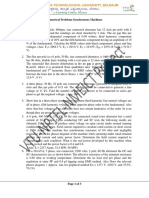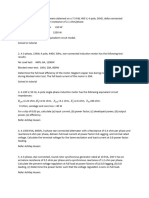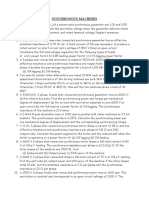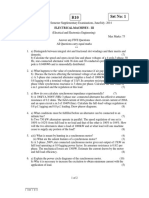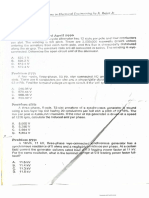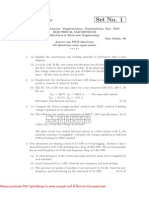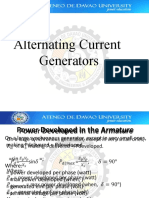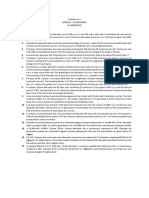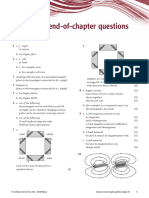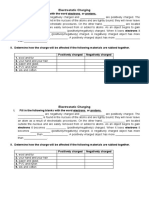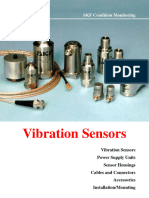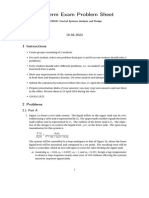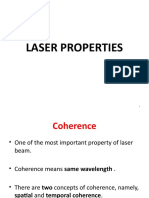Tutorial Problem 37.
5
1. A 20 MVA, 3-phase, star-connected, 50-Hz, salient-pole has Xd = 1 p.u.; Xq = 0.65 p.u. and Ra = 0.01
p.u. The generator delivers 15 MW at 0.8 p.f. lagging to an 11-kV, 50-Hz system. What is the load angle and
excitation e.m.f. under these conditions?
2. A salient-pole synchronous generator delivers rated kVA at 0.8 p.f. lagging at rated terminal voltage. It has Xd =
1.0 p.u. and Xq = 0.6 p.u. If its armature resistance is negligible, compute the excitation voltage under these
conditions.
3. A 20-kVA, 220-V, 50-Hz, star-connected, 3-phase salient-pole synchronous generator supplies load at a lagging
power factor angle of 45°. The phase constants of the generator are Xd = 4.0 W ; Xq = 2 W and Ra = 0.5 W.
Calculate (i) power angle and (ii) voltage regulation under the given load conditions.
4. A 3-phase salient-pole synchronous generator has Xd = 0.8 p.u.; Xq = 0.5 p.u. and Ra = 0. Generator supplies
full-load at 0.8 p.f. lagging at rated terminal voltage. Compute (i) power angle and (ii) no-
load voltage if excitation remains constant.
�Tutorial Problem 37.6
1. Calculate the synchronizing torque for unit mechanical angle of phase displacement for a 5,000-kVA, 3-j
alternator running at 1,500 r.p.m. when connected to 6,600-volt, 50-Hz bus-bars. The armature has a short-circuit
reactance of 15%.
2. Calculate the synchronizing torque for one mechanical degree of phase displacement in a 6,000-kVA, 50-Hz,
alternator when running at 1,500 r.p.m with a generated e.m.f. of 10,000 volt. The machine has a synchronous
impedance of 25%.
3. A 10,000-kVA, 6,600-V, 16-pole, 50-Hz, 3-phase alternator has a synchronous reactance of 15%. Calculate the
synchronous power per mechanical degree of phase displacement from the full load position at power factor 0.8
lagging.
4. A 6.6 kV, 3-phase, star-connected turbo-alternator of synchronous reactance 0.5 ohm/phase is ap- plying 40 MVA
at 0.8 lagging p.f. to a large system. If the steam supply is suddenly cut off, explain what takes place and determine
the current the machine will then carry. Neglect losses.
5. A 3-phase 400 kVA, 6.6 kV, 1500 rpm., 50 Hz alternator is running in parallel with infinite bus bars. Its
synchronous reactance is 25%. Calculate (i) for no load (ii) full load 0.8 p.f. lagging the synchro- nizing power and
torque per unit mechanical angle of displacement.
�Tutorial Problem 37.7
1. Two similar 6,600-V, 3-j, generators are running in parallel on constant-voltage and frequency bus- bars. Each has
an equivalent resistance and reactance of 0.05 W and 0.5 W respectively and supplies one half of a total load of
10,000 kW at a lagging p.f. of 0.8, the two machines being similarly excited. If the excitation of one machine be
adjusted until the armature current is 438 A and the steam supply to the turbine remains unchanged, find the
armature current, the e.m.f. and the p.f. of the other alternator.
2. A single-phase alternator connected to 6,600-V bus-bars has a synchronous impedance of 10W and a resistance of
1 W. If its excitation is such that on open circuit the p.d. would be 5000 V, calculate the maximum load the machine
can supply to the external circuit before dropping out of step and the corresponding armature current and p.f.
3. A turbo-alternator having a reactance of 10 W has an armature current of 220 A at unity power factor when
running on 11,000 V, constant-frequency bus-bars. If the steam admission is unchanged and the e.m.f. raised by
25%, determine graphically or otherwise the new value of the machine current and power factor. If this higher value
of excitation were kept constant and the steam supply gradu- ally increased, at what power output would the
alternator break from synchronism? Find also the current and power factor to which this maximum load
corresponds. State whether this p.f. is lagging or leading.
4. Two single-phase alternators are connected to a 50-Hz bus-bars having a constant voltage of 10 Ð 0º kV.
Generator A has an induced e.m.f. of 13 Ð 22.6° kV and a reactance of 2 W; generator B has an e.m.f. of 12.5 Ð
36.9° kV and a reactance of 3 W. Find the current, kW and kVAR supplied by each generator.
5. Two 15-kVA, 400-V, 3-ph alternators in parallel supply a total load of 25 kVA at 0.8 p.f. lagging. If one alternator
shares half the power at unity p.f., determine the p.f. and kVA shared by the other alternator.
6. Two 3-j, 6,600-V, star-connected alternators working in parallel supply the following loads :
(i) Lighting load of 400 kW (ii) 300 kW at p.f. 0.9 lagging
(iii) 400 kW at p.f. 0.8 lagging (iv) 1000 kW at p.f. 0.71 lagging
7. A 3 phase, star-connected, 11,000-V turbo-generator has an equivalent resistance and reactance of 0.5 W and 8 W
respectively. It is delivering 200 A at u.p.f. when running on a constant-voltage and con- stant-frequency bus-bars.
Assuming constant steam supply and unchanged efficiency, find the current and p.f. if the induced e.m.f. is raised by
25%.
8. Two similar 13,000-V, 3-ph alternators are operated in parallel on infinite bus-bars. Each machine has an effective
resistance and reactance of 0.05 W and 0.5 W respectively. When equally excited, they share equally a total load of
18 MW at 0.8 p.f. lagging. If the excitation of one generator is adjusted until the armature current is 400 A and the
steam supply to its turbine remains unaltered, find the armature current, the e.m.f. and the p.f. of the other generator.
�Tutorial Problem 37.8
1. Show that an alternator running in parallel on constant-voltage and frequency bus-bars has a natural time period of oscillation.
Deduce a formula for the time of one complete oscillation and calculate its value for a 5000-kVA, 3-phase, 10,000 V machine
running at 1500 r.p.m. on constant 50-Hz bus- bars.
The moment of inertia of the whole moving system is 14112 kg-m2 and the steady short-circuit current is five times the normal
full-load value.
2. A 10,000-kVA, 5-kV, 3-phase, 4-pole, 50-Hz alternator is connected to infinite bus-bars. The short- circuit current is 3.5 times
the normal full-load current and the moment of inertia of the rotating system is 21,000 kg-m2. Calculate its normal period of
oscillation.
3. A 10,000-kVA, 5-kV, 3-phase, 4-pole, 50-Hz alternator is connected to infinite bus-bars. The short- circuit current is 3.5 times
the normal full-load current and the moment of inertia of the rotating system is 21,000 kg-m2. Calculate its normal period of
oscillation.
4. Calculate the rotational inertia in kg-m2 units of the moving system of 10,000 kVA, 6,600-V, 4-pole, turbo-alternator driven at
1500 r.p.m. for the set to have a natural period of 1 second when running in parallel with a number of other machines. The steady
short-circuit current of the alternator is five times the full-load value.
5. A 3-phase, 4-pole, 6,000 kVA, 5,000-V, 50-Hz star-connected alternator is running on constant-voltage and constant-frequency
bus-bars. It has a short-circuit reactance of 25% and its rotor has a mo- ment of inertia of 16,800 kg-m2. Calculate its natural time
period of oscillation.


